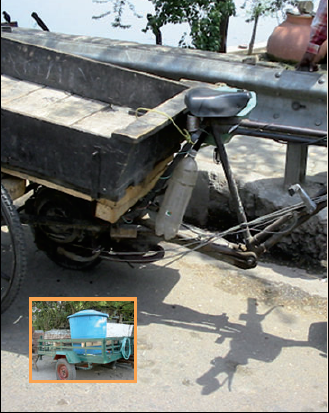Cartage system
Tricycles and push carts can be used to transport containers and oil drums containing urine or excreta. Push carts and tricycles (pedal or motorised) can access small streets. Tricycles can speed up the collection operation and increase the radius of the collection in urban areas, transporting the containers to transfer stations or to community treatment facilities. From transfer stations, urine and excreta can be loaded onto trucks or tractors, which can haul a larger volume over a long distance. Tricycles can collect door to door, although urine can also be collected in larger containers serving a number of houses.
| Advantages | Disadvantages |
|---|---|
| No water required for flushing Easty to construct with local materials |
The toilet has to be cleaned without using much water. Collected excretta have to be handled carefully, as they contain pahtogens. |
Costs
- Unreinforced concrete squatting plate (mass production) US$ 11 (Mozambique,1995).
- Conrete squatting plate US$ 9-11 (Niger, 1999), based on 40 units.
Applying conditions
- Dry toilets should only be used in rural areas where sufficients space is available at the household level for storage, treatment and use of excreta
- Dry toilets are suitable in water-scarce, flood prone regions, and on solid soils
- The system is preferably used with anal wiping (using paper, leaves, grasses, etc. for anal cleaning). However, it can also be used in combination with a special anal washing facility. Washing water should be collected separately as in the Philipines. (See also the description of dry urine diversion toilet.)
External links
- General information about Dry toilets www.ecowaters.org
- Toilet seats www.riles.org
- Squatting plates www.sanplat.com

